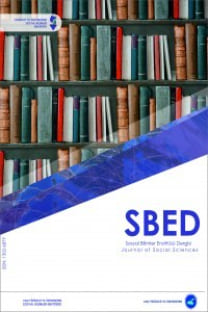Gurbetçilikten Çoklu Yerleşim Tercihlerine Doğukaradeniz Bölgesinde Nüfus, Göç ve Geri Dönüş
Bu çalışma Doğu Karadeniz Kalkınma Ajansı (DOKA) tarafından desteklenen, saha çalışmaları OPTİMAR araştırma şirketi tarafından gerçekleştirilen yürütücüsü olduğum araştırma projesinin saha bulgularına dayanmaktadır. Bilindiği gibi Ordu, Giresun, Trabzon, Gümüşhane, Rize ve Artvin illerinden oluşan Doğu Karadeniz Bölgesi, tarih boyunca ülkenin en çok göç veren bölgesi olmuştur. Yarattığı sosyo-ekonomik sorunların sıkça tartışıldığı bu durum karşısında, önerilen çözümler arasında öne çıkan göçün önlenmesine yönelik sosyo-ekonomik tedbirler ve göç edenlerin “geri dönüşlerinin teşvik edilmesi”, benzer araştırmalarda da, karşımıza çıkan temel çözüm önerilerini oluşturmaktadır. Önerilen çözüm seçeneklerinin, uygulanabilirliği, başarılı olma şansı bir tarafa, en temel açmazı sorunu göç eden, göç etmek isteyen, geri dönen, geri dönmek isteyen aktörler açısından ele almamış olmalarıdır.
Anahtar Kelimeler:
Göç, tersine göç, göç alan şehir
FROM GUEST EMPLOYMENT TO MULTIPLE SETTLEMENT OPTIONS: POPULATION, MIGRATION AND HOMECOMING IN THE EASTERN BLACKSEA REGION
The purpose of this paper is to investigate current migration patterns in East Black sea region from historical perspectives. The paper based on the field study conducted in six sending cities of East Black sea with high rate of outgoing migration, namely Ordu, Giresun, Trabzon, Gümüşhane, Rize, Artvin, and five destination cities with high rate of incoming migration from the region, namely, Ankara, İstanbul, Bursa, Kocaeli and Samsun. The field study conducted between 1. January and 31. May in 2020. Mixed research methods used in the study. A total of 1775 questioners and 110 in-depth interviews applied to the sample from six departure and five destination cities. Focus group used only in departure cities.
The findings of the study show that current migration patterns of migration in the region have been shaped as early as 19th. Century. It shows that the only option for migrants and prospective migrants is not between migration and return home but a combination of new life spaces freely designed from a rich option of wide selections.
Keywords:
Migration, return home, departure cities,
___
- 1. BEYAZ, Cenk, Kırsal Göçmenin Kimlik, Aidiyet ve Bağlılık Mücadelesi: Rizeli Göçmenler Üzerine Bir Çalışma, HÜ, Sosyal Bilimler Enstitüsü, Yayınlanmamış Doktora Tezi, Ankara, 2019.
- 2. BİRYOL, Uğur, (2007) Gurbet Pastası: Hemşinliler, Göç ve Pastacılık, İletişim, İstanbul, 2007.
- 3. BOURDIEU, Pierre, “The Forms of Capital”, John Richardson ( ed.), Handbook of Theory and Research for the Sociology of Education, Greenwood, Westport, 1986, s. 241–58.
- 4. BRAUDEL,Fernand, II. Felipe Döneminde Akdeniz ve Akdeniz Dünyası, Cilt 1, İmge Yayınevi, Ankara, 1993.
- 5. GRABBE, Lester, “Exodus and History”, Thomas Dozeman vd., The Book of Exodus: Composition, Reception, and Interpretation. Brill, Leiden, 2014, s.61–87.
- 6. GURAK, Douglas T. vd., "Migration Networks and the Shaping of Migration Systems", Mary M. Kritz vd, (ed), International Migration Systems: A Global Approach,. Clarendon Press, Oxford, 1992, s. 150-176.
- 7. HALDUN, İbn, Mukaddime, C 1, Dergah Yay., İstanbul, 1985.
- 8. HAMİDULLAH, Muhammed, İslam Peygamberi, Beyan Yayınları, İstanbul, 2011.
- 9. İmar ve İskan Bakanlığı (1972). Doğu Karadeniz Bölgesi: Bölgesel Gelişme, Şehirleşme ve Yerleşme Düzeni, Bölge Planlama Dairesi, Ankara, 1972.
- 10. JANSEN, C.J. Readings in the Sociology of Migration, Pergamon Press, Oxford, 1970.
- 11. LEE, Everett S. “A Theory of Migration”, J.A. Jackson (ed.), Migration, Cambridge University Press, Cambridge, 1969, s. 283-297.
- 12. RASONYI, László, Tarihte Türklük, Örgün Yayınevi, İstanbul, 2008.
- 13. RAVENSTEIN, E. G. “The Laws of Migration”, Journal of the Statis¬tical Society of London, C 48, S 2, London, 1885, s. 167-235.
- 14. ROUX, Jean Paul, Türklerin Tarihi: Pasifik’ten Akdeniz’e 2000 Yıl, Kabalcı, İstanbul, 2004.
- 15. SAÇLI, Yurdakul, Türkiye’de Tarım İstatistikleri, DPT, Ankara, 2009.
- 16. SINHA, V.N.P. vd. Migration: An Interdisciplinary Approach, Seema Publications, Delhi, 1987.
- 17. SOWELL, Thomas, Migration and Cultures: A World Aiew, Basic Books, New York, 1996.
- 18. TEKELİ, İlhan, Göç ve Ötesi, Tarih Vakfı Yayınları, İstanbul, 2010.
- 19. TRT BELGESEL, Pastacı Uşaklar, https://www.dailymotion.com/video/x4v5b7v
- 20. VEN, Rutger van der vd. The Demographic Window of Opportunity: Age Structure and Sub-National Economic Growth in Developing Countries, Nijmegen Center for Economics, Working Paper, s.11-102, Nijmegen, 2011.
- 21. YALÇIN, Cahit, Göç Sosyolojisi, Anı Yayıncılık, Ankara, 2004.
- 22. YAVUZ, Fahri, Türkiye’de Tarım, Tarım ve Köy İşleri Bakanlığı, Ankara, 2005.
- ISSN: 1302-6879
- Başlangıç: 2000
- Yayıncı: Yüzüncü Yıl Üniversitesi Sosyal Bilimler Enstitüsü Müdürlüğü
Sayıdaki Diğer Makaleler
Tang Hanedanlığında Bir Türk: An Lushan (安禄山)
Erciş İlçesinde (Van) Köy Adlarının Coğrafi Açıdan İncelenmesi
Gurbetçilikten Çoklu Yerleşim Tercihlerine Doğukaradeniz Bölgesinde Nüfus, Göç ve Geri Dönüş
Seda Başar YILMAZ, H.eray ÇELİK
Büyük Beden Kadınlar için Hazır Giyim Üretiminde Kullanılacak Beden Ölçüleri Standardizasyonu
Mevlid Geleneği ve Bu Geleneğin Van Din Görevlilerince Din Eğitimi Açısından Değerlendirilmesi
Berkan ÇELİK, Sinan KESKİN, Murat KAYRİ
Felsefî Kaynaklar Işığında Şahsiyet ve Değer Eğitimi
